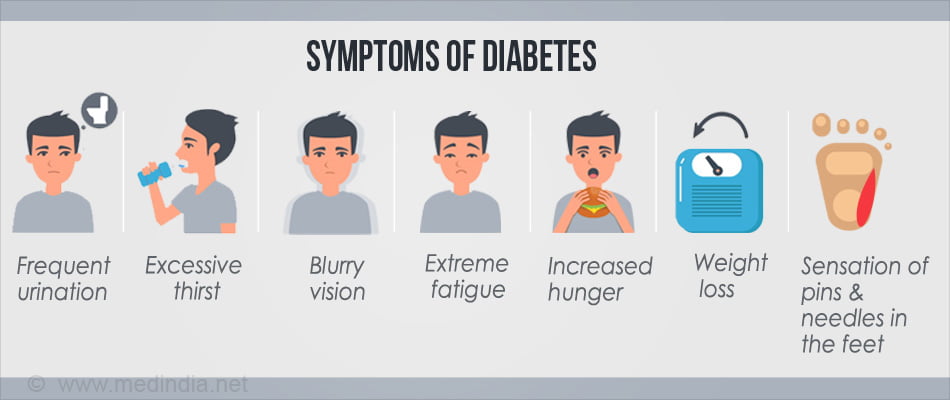
By Franziska Spritzler, RD![]() , medical review by Dr. Bret Scher, MD,
, medical review by Dr. Bret Scher, MD,
Over the past 35 years the number of people with diabetes worldwide has increased four-fold and currently stands at more than 400 million, according to the World Health Organization. What’s more, millions are unaware that they have diabetes or its precursor, prediabetes.
Could you have diabetes? It’s a disease with many early symptoms; although some are subtle, others are hard to ignore. Read on to learn about the most common symptoms of diabetes and what you can do if you have them.
1. What is diabetes?
Diabetes is a chronic disease characterized by high levels of sugar (glucose) in the bloodstream. Although it can take several forms, type 1 and type 2 are the most common.
- In type 1 diabetes, pancreatic cells that produce the hormone insulin are destroyed as the result of an autoimmune process. Therefore, people with type 1 diabetes can no longer produce insulin on their own and must inject insulin in order to survive.
- In type 2 diabetes, the pancreas usually produces insulin, but the body doesn’t use it effectively. Over time, the pancreas may lose its ability to make enough insulin to maintain normal blood sugar. Type 2 diabetes is also called non-insulin-dependent diabetes because people with this form of the disease continue to produce some insulin.
A related and very important condition is prediabetes, in which blood sugar is higher than normal but not high enough to be classified as diabetes. Additionally, both fasting and post-meal insulin levels are usually elevated.
Over time, prediabetes may progress to type 2 diabetes; however, it carries some of the same health risks of diabetes, even if blood sugar remains in the prediabetes range.
Additionally, it usually does not have the same constellation of symptoms from elevated blood sugars, but some of the more subtle symptoms may present even in prediabetes.
2. Symptoms of diabetes
These are some of the most common symptoms of diabetes. You may have one, two, or several of them — or you may have none. Please remember, an absence of symptoms does not mean an absence of diabetes. However, being alert to potential symptoms may help make the diagnosis much earlier and thus prevent potential long term complications
Increased thirst and urination
 Have you been feeling very thirsty or running to the bathroom more often lately? Frequent urination coupled with a near-constant sensation of thirst are well-known signs of diabetes.
Have you been feeling very thirsty or running to the bathroom more often lately? Frequent urination coupled with a near-constant sensation of thirst are well-known signs of diabetes.
When blood sugar is too high, water is pulled from your bloodstream and organs to help your kidneys flush out the excess glucose. The sugary urine smells sweet – and even tastes sweet. In fact, although it’s rather unsettling to think about, tasting patients’ urine helped doctors identify diabetes before blood tests and glucose meters were available. Because so much water is leaving your body, the brain triggers your thirst mechanism in order to ensure that you drink enough to replace what is being lost.
Excessive thirst and urination is more common in type 1 diabetes when blood sugar levels are very high but may also occur late in type 2 diabetes.
In a study of over 1,100 people recently diagnosed with type 2 diabetes, more than half reported increased urination, and nearly two-thirds reported being abnormally thirsty.
Severe fatigue
Although there are hundreds of conditions that can cause fatigue, it’s a symptom that often accompanies diabetes. In undiagnosed diabetes, fatigue can be quite pronounced; you may feel so tired that you can barely keep going during the day, despite getting plenty of sleep.
Why does diabetes make you feel tired? One theory is because glucose — one of your body’s major fuel sources — is accumulating in your bloodstream rather than getting into your cells.
The pancreas produces the hormone insulin, which allows glucose to enter your cells. When your body doesn’t produce insulin or your cells are resistant to its effects, glucose remains in the blood. As a result, you may feel tired and weak because your cells are deprived of the fuel they need.
Studies confirm that many people with newly diagnosed diabetes report fatigue as one of their main symptoms.
Feeling hungrier than usual
It’s normal for your appetite to vary somewhat based on activity, sleep, mood, and dozens of other factors. However, if you’ve recently been much hungrier than usual, diabetes could be the reason. Along with frequent urination (polyuria) and thirst (polydipsia), severe hunger (polyphagia) is one of the “Three P’s” considered to be classic symptoms of diabetes.
Increased hunger is related to another diabetes symptom, fatigue. Your body breaks down carbohydrates into sugar (glucose) to be used as energy. But if glucose can’t get into your cells due to a lack of insulin or insulin resistance, your body may perceive this as starvation. Therefore, you become hungrier and more tired than ever — even if you’re eating as much or more than usual. Unfortunately, eating more food usually doesn’t satisfy this hunger. What’s more, reaching for carbohydrate-rich foods (including fruit, legumes, and whole grains) will cause blood sugar to increase even further.
Although it can occur in type 2 diabetes, a significant increase in hunger is especially common in type 1 diabetes.
Unexplained weight loss
 Losing weight as a result of making diet and other lifestyle changes is a welcome and expected outcome. However, if it happens when you haven’t changed what or how much you eat, something is amiss. Everyone experiences small weight fluctuations from day to day, but if you’ve lost 10 pounds (5 kg) or more without trying, diabetes may be the cause.
Losing weight as a result of making diet and other lifestyle changes is a welcome and expected outcome. However, if it happens when you haven’t changed what or how much you eat, something is amiss. Everyone experiences small weight fluctuations from day to day, but if you’ve lost 10 pounds (5 kg) or more without trying, diabetes may be the cause.
In addition to allowing glucose to enter your cells, insulin helps prevent muscle and fat breakdown. If you have diabetes, your pancreas isn’t making sufficient insulin or your cells aren’t using the insulin properly. Therefore, your body begins to break down fat and muscle, leading to weight loss. This typically happens in type 1 diabetes. Although weight loss is usually considered a rare and very late sign in type 2 diabetes, there are indications that some populations may exhibit weight loss in conjunction with type 2 diabetes more often than others.
Unexplained weight loss is more common in people with type 1 diabetes — including children and lean adults who can’t afford to lose weight — but may also occur in people with type 2 diabetes. In one study, slightly more than one-third of people newly diagnosed with type 2 diabetes reported that they had recently lost weight unintentional.
Delayed healing of injuries
Have you noticed that cuts, scrapes, or other injuries have been taking longer to heal than usual? This may be a warning sign of diabetes.
Research suggests that elevated blood sugar drives inflammation and impairs the immune system’s ability to repair wounds effectively.
In a setting of high blood sugar, minor injuries might take weeks or months to heal rather than days.
Blurred vision
 Sometimes blurry vision isn’t a sign that you need a new prescription for eyeglasses. It could actually be a symptom of diabetes.
Sometimes blurry vision isn’t a sign that you need a new prescription for eyeglasses. It could actually be a symptom of diabetes.
When blood sugar is elevated, it causes the lens of the eye to swell, which changes its shape. When this occurs, the lens can no longer focus light properly, causing vision to become cloudy. When blood sugar levels return to a healthy level, the lens goes back to its usual shape, and vision becomes normal again. In one study, about one quarter of people with newly diagnosed diabetes reported that their vision had become blurry.
Numbness and tingling in feet or toes
The “pins and needles” feeling we’re all familiar with usually occurs after sitting in one position for a while or putting too much pressure on one part of the body. However, if it occurs in your feet or toes for no apparent reason, diabetes or prediabetes could be responsible.
Elevated blood sugar can damage the nerves leading to your feet, resulting in numbness and tingling The medical term for this condition is diabetic peripheral neuropathy. Importantly, blood sugar does not need to be very high for this damage to occur; in one study, 49% of people with prediabetes and 50% of those with newly diagnosed diabetes were found to have peripheral neuropathy.
Dark patches of skin
 Have dark, velvety patches of skin developed over certain parts of your body, especially the creases of your armpits, groin or neck? Do they appear grayish, brown or black?
Have dark, velvety patches of skin developed over certain parts of your body, especially the creases of your armpits, groin or neck? Do they appear grayish, brown or black?
The medical term for these patches is acanthosis nigricans, which may be caused by several conditions but often reflects elevated insulin levels and insulin resistance.
It has also been linked to type 2 diabetes, especially in those who are overweight or obese. In one study of people newly diagnosed with type 2 diabetes, 54% of those who were obese had acanthosis nigricans.
Skin lesions or rashes
Rashes, lesions, and other skin problems may be an early warning sign of diabetes.
Several skin conditions — including eruptive xanthomatosis, necrobiosis lipodica, and diabetic dermopathy — are characterized by itchy rashes or painful blisters that appear when blood sugar is too high. Although the precise mechanism for these and other diabetic skin disorders isn’t clear, elevated blood sugar may lead to inflammation and interfere with the ability to grow healthy new skin cells to replace old ones. One large review of existing studies found that between 51-97% of people with diabetes worldwide had some type of diabetes-related skin disorder.
Yeast and urinary tract infections (women)
Have you been experiencing yeast infections or urinary tract infections (UTIs) more often lately? Frequent infections may be an early warning sign of diabetes, and this includes yeast infections and (UTIs) in women. High blood sugar fuels the growth of both Candida (the fungus responsible for vaginal yeast infections) and several types of bacteria that can cause UTIs. In addition, elevated blood sugar levels may depress immune function, making your body more susceptible to these infections.
Erectile dysfunction (men)
In men, one of the first signs of diabetes may be difficulty with sexual function. High blood sugar can affect the nerves and blood vessels that lead to reproductive organs, resulting in erectile dysfunction. Studies have found that men with diabetes are more than three to five times as likely to have erectile dysfunction compared to non-diabetic men.
3. How to find out if you have diabetes
If you have one or more of the symptoms above and suspect you may have diabetes, it’s important to make an appointment with your primary care provider. He or she will perform an examination and order lab tests to confirm whether you have type 1 diabetes, type 2 diabetes or prediabetes, and to rule out other causes of your symptoms.
You can also test your blood sugar at home to see if it is elevated. Regardless of the results, be sure to follow up with your healthcare provider if you have any symptoms of diabetes.
Importantly, in many cases, you may have no obvious symptoms of prediabetes or early-stage type 2 diabetes.
4. What can you do if you have diabetes or prediabetes?
If you have been diagnosed with diabetes or prediabetes, you’re likely to be upset and concerned. Although this is completely understandable, take heart. In addition to following up with your doctor on a regular basis, there are steps you can take right now to get your blood sugar under control and make sure it stays there.
In fact, in many cases, type 2 diabetes and prediabetes can be reversed with a low-carbohydrate diet. Check out our guide below.
And although type 1 diabetes cannot be reversed, following a low-carbohydrate diet can help control blood sugar. See our guide below.
Finally, please don’t ignore the symptoms of diabetes, no matter how subtle they seem. It’s never too early to see your doctor and get checked out — or to start following a low-carb diet to achieve healthy blood sugar levels.
Furthermore, even if your blood sugar is normal now, limiting sugary and starchy foods may help to keep it that way. This doesn’t mean going on a diet, just eating better. Take a look at our guide below on six steps you can take to eat better.
Source: https://www.dietdoctor.com
Disclaimer: We at Prepare for Change (PFC) bring you information that is not offered by the mainstream news, and therefore may seem controversial. The opinions, views, statements, and/or information we present are not necessarily promoted, endorsed, espoused, or agreed to by Prepare for Change, its leadership Council, members, those who work with PFC, or those who read its content. However, they are hopefully provocative. Please use discernment! Use logical thinking, your own intuition and your own connection with Source, Spirit and Natural Laws to help you determine what is true and what is not. By sharing information and seeding dialogue, it is our goal to raise consciousness and awareness of higher truths to free us from enslavement of the matrix in this material realm.
 EN
EN FR
FR

























